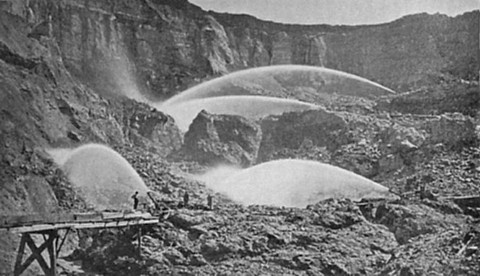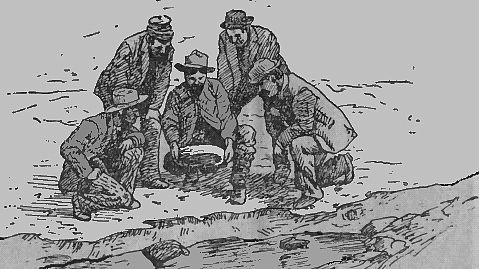The intelligent men who worked the gulches and rivers in an early day, soon sought the sources of the gold. Sometimes gold was found with quartz adhering to it, or occasionally a quartz pebble riveted through and through with gold. The veins of quartz seaming the hills in the vicinity of the richest placers, also served to point to that rock as the original source of the gold. At Carson Hill, in what was then Mariposa county, quartz had been found immensely rich; but the expense of blasting the rock out and crushing it was such, that no serious attempts were made, in Amador county, until 1851. The whole country abounded with quartz; in some places there were mountains of it, which had filled the ravines with broken quartz, where no gold was to be found; so that the search for auriferous quartz was a tedious affair until men were put upon the scent.
The first discovery of gold in quartz seems to have been made by a man by the name of Davidson, a Baptist preacher, in February, 1851, on the south side of Amador creek near the spring then used by the miners. Boulders of considerable size were lying on the top of the ground, supposed to have been detached from the vein. Gold was found in some of these, and subsequently, in the vein from which these came.
Associated with Davidson were Glover, Herbert, and P. Y. Cool, all ministers; hence the claim was known as the "ministers' claim." Samuel Hill, afterward a resident of Buckeye, was taken in as a capitalist, and the company organized as the Spring Hill Company. About the same time, Thomas Eickey, and his son James, afterward residents of lone, located the vein on the north side of the creek, since known as the Original Amador. Gold could also be seen in this rock. None of these men had ever seen any quartz mining; in fact, there was none in the world to compare with what may be seen now at any mining town. Hill, of the Spring Hill Company, went to Sacramento and bought a steam engine, aged and ancient in style, which proved a mine of trouble to them, as it took an enormous quantity of wood to make steam. The main shaft was wood with bearings of round bar iron, two inches in diameter, which were driven in with a hammer, the end of the log being banded with iron. The cams were large spikes of bar iron driven into the shaft and afterward bent. The stamps had wooden stems, and spikes driven into the stems for tappets or projections, against which the cams should play to raise the stamps. The gold was saved, or rather lost, by means of a rocker about eight feet long, worked by the same power as the stamps.
The machinery proving a failure, the gold mill was soon rebuilt with improvements suggested by experience. The mill on the north side was started about the same time, September 5, 1851, with somewhat better machinery. The shaft was of wood, but had axe-bar iron four inches wide and half an inch thick for cams, the bars being bent after they were put in the shaft. The stamps also had wooden stems with slots in the middle to receive the cams. Dan Fiddler was the master mechanic, and J. T. Berke the superintendent of this mine. It made dividends as well as wages for its owners, who were all workers.
Quicksilver was tried, but from some cause failed to give satisfactory results. It was also discovered that much of the gold was lost, being too fine to settle into the ordinary riffles. While experiments were being made to remedy the matter, a German who had had experience in mining in Peru, pro posed to amalgamate with arastras. With his assistance the company took out about seventy-five ounces a week, the German receiving one-thirteenth part for his share. This was the first successful quartz mining in the county.
QUARTZ MINERS'
CONVENTION
The discovery of gold-bearing quartz aroused the whole country. All were
looking forward to the time when the gulches and surface claims should be
exhausted, and there were numbers of men who thought this was the case as
early as 1851. Quartz was now tried everywhere; like any other mining craze
it went beyond all reasonable bounds. Possibilities became certainties. A
mill had been put up at Quartzburg on the Cosumnes river which was thought
to be making fabulous fortunes for its owners, which, however, was far from
true. It may as well be told here that the superintendent, Dr. Harris, a
native of Nashville, Tennessee, brought out seventeen thousand dollars to
work the mine, drew on the company for twenty-eight thousand dollars more,
and then abandoned the mine to the hired hands to make their back wages out
of it if they could. The lead or Mother Lode, as this system of veins,
chutes, or chimneys, has been called, was soon traced to the Cosumnes on the
north, and the Mokelumne on the south. All kinds of claims were set up and a
harvest of lawsuits seemed impending, when it was resolved to hold a quartz
convention and make regulations to ensure the peace and security of quartz
mining, which, after a proper notice, was held at Rancheria that being
probably the largest place in the county.
Anticipating that Quartz mining was now fairly inaugurated, in a short time, the Granite State, the Herbertville, the Union. Eureka, Badger, Wolverine (the last three being consolidated in the Hayward mine), Oneida, all came in a short time. The Granite State was the first to put up a mill with iron shaft, tappets and stems. John Conness was a stockholder in this mine. Garfield, afterwards Governor of Washington Territory, invented the stamp with tapering stem and socket, to correspond. Shaking tables were introduced in 1852, and were in use until 1860. The Chilean mill, with rotating balls and revolving barrel, was introduced by P. M. Randal. The last is still used in some places. Roasting the ore was tried, but, though it was more easily pulverized, it was soon abandoned as not satisfactory. The sulphurets were saved by means of blankets or rawhides, placed along the bottoms of the sluices, and amalgamated in the Chilean mill, or revolving barrel.
THE MOTHER LODE
Perhaps no term more inappropriate could have been selected. The name is
inappropriate because there is no principal lode or vein at all, but rather
a series or system of veins, chutes or chimneys along a certain range of
country, varying in width from two hundred to four thousand, or perhaps
eight thousand feet. In some places there are hundreds of veins, as on the
Black hills and Murphy's ridge, some of which are mere threads, ramifying in
every direction. In other places, the ore-bearing ground is narrowed within
walls two or three hundred feet apart, as at the Keystone, Plymouth, and the
Hayward mines; though even here, as we shall see, the ore is not
concentrated in a single vein. The term mother, is also misleading, for it
gives the idea that all other veins are connected somehow, and fed from
this, than which nothing could be more erroneous. Evidently, the first
theorists presumed that all mineral veins came out of the interior regions
of the earth, where the fires are always glowing, and that down some
thousand feet all the veins of quartz, big and little, would come together
in one main lode, extending the whole length of the State, or as far as the
gold range extends.
SKETCH OF THE DIFFERENT MINES.
The Gwin mine, though in Calaveras county, is really the beginning of the series of veins which have made Amador the richest quartz mining county in the State of California. This is in Rich gulch, which is supposed to have derived its wealth from the breaking down of the vein matter. The owner, Dr. Gwin, is better known as Duke Gwin, from his having that title conferred on him for valuable aid to the Emperor Maximillian of Mexico. The mine is said to be paying well. The series of veins here is quite wide, several other veins cropping out a thousand feet or more to the east.
The Casco mine is on the north side of the Mokelumne River, and consequently in Amador county. This mine was worked in 1868 by J. E. Hardenburg some eight hundred feet deep, the rock being crushed by a water-mill of twenty stamps, not far from the mine. The owner sunk twenty thousand dollars in the operation. The Casco mine is on the eastern side of the range, which here is quite wide. Abraham McKinney has a mine on the west side of the range, which is yet undeveloped, but which shows some very rich specimens, some of which are of singular appearance, containing gold in crystalline forms in coarse granulated quartz. Persons who entertain an opinion that gold is deposited in a melted state, will find a puzzling problem in these specimens; The rock east of here (hanging-wall) is syenitic or stratified rock, resembling granite, varying in texture and character at every dividing seam. On the west the wall rock (foot-wall) is the hard metamorphic slate sometimes termed by the miners "blue granite."


